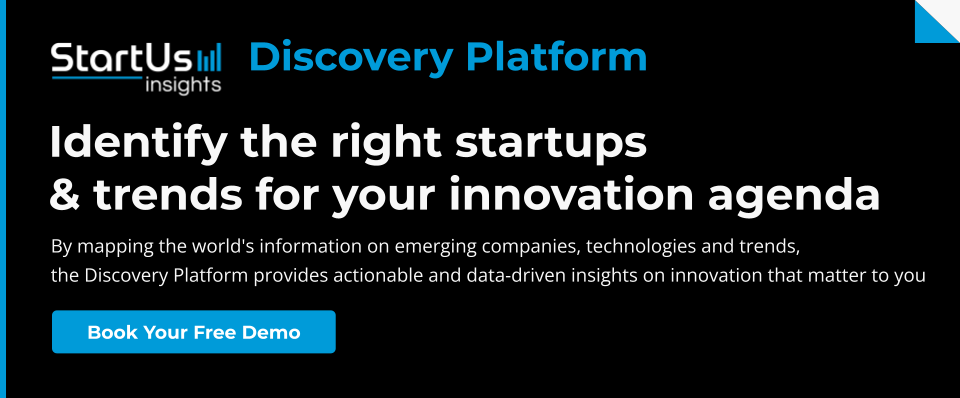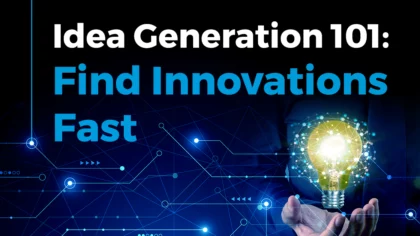Accelerate Productivity in 2025
Reignite Growth Despite the Global Slowdown
Think of the question – how can we get people to eat less meat? Many companies are trying different novel methods to grow meat artificially. No matter the breakthroughs, the answer to the question will be – whenever there is a better alternative. Not in terms of its sustainability but rather in terms of its closeness to real meat. Only if artificial meat improves in quality will more people be tucking into their vegan meat steaks. Similarly, for any new idea to be successful, it must stand out from the rest in its core aspects.
Companies can do this by creating a distinctive product or service that is better than what is currently available in the market. Think of how Apple was able to create a popular smartphone with a simple user interface that appealed to a wide range of customers.
By doing this, they were able to build a base of customers who would become loyal users of their products over time. The tech giant also created an innovative business model that enabled them to make money even when only a small number of people owned their product. Once they had created these two key elements, they were then free to focus on building out their go-to-market strategy so that they could start generating revenue.
Now, coming back to our steak, finding the perfect piece of sustainable meat is quite a challenge. And so is coming up with ideas to invest in. This is called the process of ideation or idea generation.
Is Brainstorming Enough for Idea Generation?
When starting with ideation, it is not uncommon to stick to traditional brainstorming. No doubt it is useful. But, it is no silver bullet. The problem with brainstorming is that it is a one-sided activity in which everyone writes down ideas. It does not promote critical thinking and analysis nor does it create any new knowledge.
Brainstorming also assumes that everyone has access to the same knowledge and expertise. This assumption rarely holds true in organizations, as people have different levels of knowledge and expertise. If you still want to try brainstorming, there are some best practices you can follow:
- Gather a diverse team that has different perspectives
- Let everyone speak and listen to them carefully
- Do not get lost in the details, focus on getting as many ideas as possible
- After collecting the ideas, ask your team to vote on them
If you want to move beyond traditional brainstorming, keep on reading to explore!
Read this next: 3 Brainstorming Tools for Innovation Managers
Experiment with Top Idea Generation Techniques
Creativity is a key element in any idea generation process. It opens up new angles, perspectives, and ways of looking at things. Creativity enables us to come up with novel solutions to problems and find alternative ways of addressing challenges or opportunities.
Creativity is not something that only artists and authors tap into. Everyone can be creative — you just need the right inspiration and techniques to get the juices flowing first, and later, again and again. There are different ideation techniques you can use when working on a project or challenge, especially if you are feeling stuck.
Some of these techniques are more suitable for individual brainstorming while others work better in groups. Each has its own benefits and disadvantages, so it is important to understand your team dynamic before choosing one over another. Let’s dive into the top ideation techniques!
Idea Challenge
As the name suggests, an idea challenge is an ideation technique that is focused on generating ideas centered around a theme. Idea challenge usually has two approaches:
- Problem centric
- Solution centric
The former involves identifying certain challenges. Whereas, the latter focuses on creating potential solutions. So, before conducting the process, you should clearly define what you are looking for. If your aim is to collect a lot of ideas, an idea challenge is the best technique. However, if you plan to involve a limited number of experts, this method is not ideal.
Idea challenge allows you to quickly gather lots of ideas. But, this requires extensive planning and dedicated resources. Don’t have the bandwidth for both? No worries! You can always consider the other methods.
SCAMPER Technique
Bob Eberle came up with the SCAMPER technique that streamlines problem-solving and creative thinking. This method involves altering some parts of an existing idea or process to achieve the best possible solution. SCAMPER has seven components:
- Substitute — replace a part of your product, service, concept, or process to further improve the outcome.
- Combine — experiment with the possibility of mixing two ideas into a single solution, which is more effective.
- Adapt — analyze the existing idea, concept, or process and explore ways to bring about incremental improvements.
- Modify — zooming out to the bigger picture of the problem or opportunity and concentrating on enhancing the overall impact and not just the idea in question.
- Put to another use — think about how you can use an existing solution or a new idea to serve another purpose.
- Eliminate — consider the probable outcomes if you eliminate one or more portions of the current process, concept, idea, or solution.
- Reverse — what if you reverse the order of the interchangeable components of an idea?
When it comes to new ideas, corporates often run towards breakthrough innovations. As a result, it is easy to forget what you already have. The SCAMPER technique throws light on potential areas for constant incremental enhancements – crucial for driving positive outcomes in the long run.
Analogy Thinking
Have you ever tried to figure out what exactly makes a certain company so successful? But, have you also tried to implement the same in the context of the industry you are in? If the answer is yes, then you are already practicing analogy thinking.
So, this ideation technique is all about analyzing what a successful business is doing right and then applying those strategies to your company. This way, you can come up with ideas that are already proven to work well, while also customizing them for your product or service.
Co-creation
Co-creation is when a company works with customers to generate new ideas and concepts. The core concept behind co-creation is that the customers have the knowledge and insights that a company lacks. Therefore, working together helps both parties come up with new and innovative ideas.
Co-creation can take place at all stages of the product development process. The early phase includes customer feedback surveys or interviews. Whereas, the later stages involve beta testing or customer hackathons. Co-creation can also happen in-house, where an innovation team interviews existing employees or talk to stakeholders.
How to Leverage Data for Ideation?
As artificial intelligence (AI) continues to progress, data is playing a larger role in the innovation process. How can you tap into this?
At StartUs Insights, we develop an Innovation Scouting Platform that helps companies like yours to keep a tab on the market — what’s new, what’s changing, what has the maximum scope, and other strategic questions.

Using our big data and AI-powered software, you can:
- Analyze billions of data points from various startups and technologies
- Map the data with AI and expert knowledge
So, what does this mean for your company?
- Discover Opportunities Before Others — Our proprietary technology enables you to discover relevant startups, technologies, and business cases early on. Hence, you can empower your business units with actionable, data-driven insights.
- Detect Pivotal Changes — We continuously monitor the startup ecosystem to detect pivotal changes.
- Map the World of Tomorrow — Our advanced data mapping process provides you with a bird’s-eye view of the emerging technology landscape. Use our comprehensive Innovation Maps for effective decision-making.
That is not all. We also provide you with a Trend Intelligence solution that gives you access to 29 500+ trends and technologies. This allows you to:
- Anticipate Future Trends & Business Opportunities — we deploy advanced analytics to hundreds of thousands of trusted sources on startups, emerging technologies, and industry trends to provide you with accurate insights into trends impacting your industry in a short amount of time.
- Stay Up to Date — Monitoring the business ecosystem continuously ensures the identification of emerging technologies, trends, and opportunities. Our service provides you with regular updates on recent developments through Trend Intelligence Reports, Innovation Maps, and Real-time Databases.
Also read: How does Trend Analysis drive Innovation?
All this structured data and granular analysis of the same along with monitoring emerging trends and technologies in your industry helps you improve your company’s ideation process. We ensure that your decision-making process is built on the most recent insights available.
How to Get the Most Out of Your Idea Generation Methods?
Generating ideas is only the first step in the innovation process. The next step is to filter out irrelevant and unhelpful ideas, so you can focus your team’s time on the most promising ones. If you don’t filter your ideas effectively, chances are that your team will spend an inordinate amount of time and effort considering suboptimal concepts.
Instead of letting that happen, you should look for ways to make the most of your idea generation efforts. This way, you’ll be able to identify the best new concepts during your initial ideation sessions.
Here are some tips that might help:
- Define the Problem Clearly — “A problem well-stated is a problem half-solved” (Charles Kettering, Head of Innovation, General Motors). So, leave no stones unturned when it comes to clearing your concept about what is it that you are trying to solve or achieve and communicate the same amongst the people involved in the ideation process.
- Set Small Constraints — While ideation aims at gathering as many ideas as possible, it is also important to collect relevant ideas. To ensure that, set some small constraints so that the ideas are more targeted toward your goal.
- Involve the Right People — To ensure maximum productivity in your ideation activities, engage the people who are well-versed in the topic that you are working on. Also, do not forget to ask them if they are genuinely interested.
Important KPIs to Track Your Idea Generation Efforts
Idea generation is not a one-time process. The success of your innovation efforts, and, in turn, your company’s future, hinges on how well you measure your ideation initiatives.
A well-thought-out plan for tracking key performance indicators (KPIs) will help you monitor the status of your ideation efforts at every stage of the process. If you do not keep track of the indicators, it will be nearly impossible to know if you are moving in the right direction and meeting your business objectives.
Here are a some of important KPIs that you should track:
Idea Churn Rate
Idea churn rate is the percentage of ideas that have been discarded over the lifetime of an initiative — more precisely, the number of times a given idea has been generated, selected, and then rejected. In most cases, the churn rate of ideas tends to increase over the lifetime of an initiative. However, you can use this information to your advantage. Idea churn rate helps you identify potential pitfalls in your process, like overly strict criteria or a lack of subject matter expertise.
Quality of Ideas
Idea quality usually varies across departments and employees. Some employees will have more creative ideas than others. Some departments will have more technical knowledge than others. Ideation is a continuous cycle that requires organizations to review and re-review ideas over time. The best ideas may not be the ones that are initially submitted. Instead, they may be the ones that receive the most votes after a number of rounds of review.
Your ideation initiative may generate thousands of ideas, but only a handful may make it to the final selection. It is important to track the quality of these ideas over time to see which ones are most promising. Idea quality can be tracked in different ways:
- Employee feedback surveys to gauge the general sentiment surrounding your ideas.
- Surveys to gauge the level of subject matter expertise in each department — the more knowledgeable a department is, the more valuable its ideas will be.
Also read: Are You Already Tracking These 4 Innovation KPIs?
Ready to Level up Your Company’s Idea Generation Process?
The best way to come up with new ideas is by keeping an open mind and not being too attached to a particular outcome. Encourage your team members to be creative and challenge the status quo. This will help them spark fresh insights and generate more innovative solutions.
Idea generation is a continuous process. You can never stop coming up with new ideas. The trick is to distill them into actionable solutions so that they are implemented as soon as possible. If you are stuck in your ideation efforts, draw up a list of challenges or opportunities that you want to improve, and think about how you can apply one or more of the techniques discussed above to help you.

![Future of Robotics: 12 Trends Powering the Next Wave [2025-2030]](https://www.startus-insights.com/wp-content/uploads/2025/06/Future-of-Robotics-SharedImg-StartUs-Insights-noresize-420x236.webp)
![Innovation During Recession: Key Data-Driven Strategies to Thrive [2025-2026]](https://www.startus-insights.com/wp-content/uploads/2025/06/Innovation-during-Recession-SharedImg-StartUs-Insights-noresize-420x236.webp)
![Business Resilience Planning: 10 Strategies & Technologies to Tackle the Current Market [2025-2026]](https://www.startus-insights.com/wp-content/uploads/2025/06/Business-Resilience-Planning-SharedImg-StartUs-Insights-noresize-420x236.webp)



